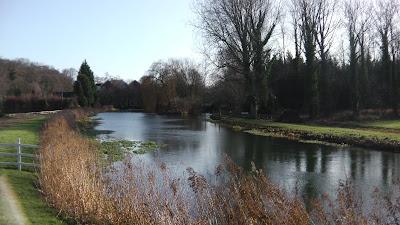As the county throws off its winter overcoat the rivers and woodlands already show signs of activity.
With this renewed activity comes a host of distractions.
Distractions are cuddly little creatures that amble innocently toward you like lost puppies and before you know it they are demanding a great deal of care and attention and in my case a large slice of filming-time.
My main objective this year is to complete the film I started more than two years ago - if only I can resist those dreaded distractions that seem to be all around me.
 |
| The Bure at Oxnead |
The two main distractions over the last twelve months have been the Aylsham Navigation and the North Walsham and Dilham canal. I have spent a lot of time on both these projects and enjoyed every minute of it, meeting many interesting and dedicated people in the process.
The Bure Navigation Conservation Trust is commemorating the great flood of 1912 this year. I agreed to produce a film for them, I enjoyed myself so much I ended up making two. The double DVD set was finished two weeks ago and profits from the sale of the DVDs will raise funds for the Trust's conservation work. The ultimate plan is to make the entire nine and a half miles of this beautiful stretch of canalised river accessible to the public. All the parishes and villages along the upper Bure have worked together to make this possible. It is extremely unlikely the Aylsham navigation will ever be accessible to larger craft but it is ideal for canoes and walkers.
The upper Bure is probably one of Norfolk's best kept secrets
The DVD's are on sale through the trust's website (£7.99.) For more information on this project and the history of the navigation visit their website via the link.
http://aylsham-navigation.norfolkparishes.gov.uk/
 |
| Burgh Mill on the Aylsham Navigation. |
The North Walsham and Dilham canal is a very ambitious project, the aim is to restore the canal to a navigable waterway. It is a truly wonderful concept - the ultimate goal is to see boats using the canal once again after an absence of decades. "Ella" was the last wherry to use the canal in 1934, after that the waterway became unloved and neglected for many years.
How things have changed. Work parties of volunteers turn out at weekends in all weathers, wading knee deep in muddy mill pools, hacking through brambles and cleaning dykes and ditches. Over the last twelve months progress on the canal has been absolutely astounding. The work has progressed steadily and carefully with consideration for wildlife habitat and visual enhancement to the landscape.
For more information and news visit the EAWA website
http://eawa.co.uk/walsham.html - and look under work parties.
 |
| The Lock at Briggate Mill |
http://youtu.be/3rrANidG0hQ or click the "My You Tube Link" on the right.




